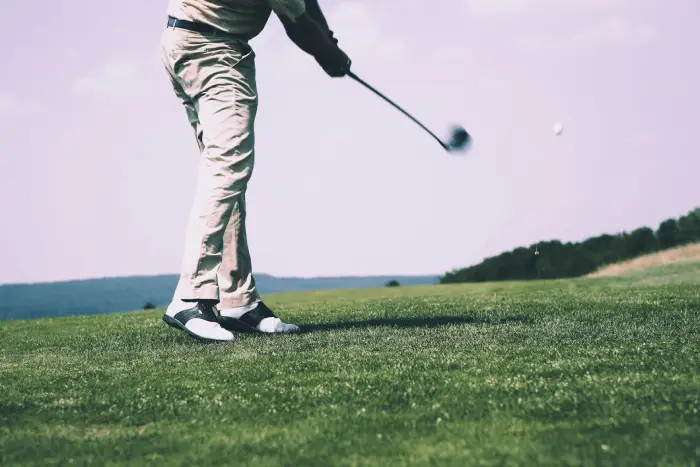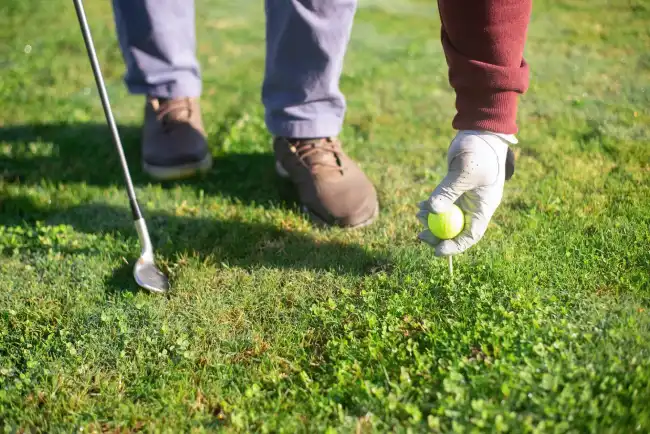Do you struggle with hitting your golf ball too low? Does it feel like you’re constantly hitting the ground before making contact with the ball? If so, you’re not alone. Many golfers find it difficult to achieve the desired height with their shots. But fear not, because we have some tips and techniques to help you hit that ball higher and improve your overall game.
If you’re struggling to hit the golf ball higher, it’s essential to understand the mechanics behind it and make adjustments to your swing and technique. By mastering the key factors involved in achieving a higher ball flight, you can add more versatility and consistency to your game. In this article, we will explore various tips and techniques that can help you hit the golf ball higher and take your golfing skills to new heights.
Easy Tips for Perfecting Your Swing Mechanics and Techniques!
If you want your golf balls to fly higher, you need to work on your swing mechanics and techniques. Adjusting the tee height, positioning the ball, and determining the angle of attack are all critical components of a proper swing, along with the focus on maintaining good posture and shoulder tilt, especially with drivers.
Tee Height Adjustment
The height at which you tee the ball can significantly impact your ability to hit it higher. For higher shots, you should tee the ball slightly higher on the tee than you would for standard shots. This allows you to strike the ball on an upward angle, promoting a higher launch. However, be cautious not to tee it too high, as this can lead to pop-ups or inconsistent contact.
Ball Position
Ball position in your stance plays a crucial role in determining the trajectory of your shots. To hit the ball higher, move it slightly forward in your stance, closer to your lead foot (left foot for right-handed golfers). This position encourages a more sweeping and upward strike on the ball, creating the desired higher launch.
Angle of Attack
The angle of attack is the angle at which the clubhead approaches the ball. To achieve higher shots, you should focus on a positive angle of attack, meaning the clubhead should be ascending as it contacts the ball. This requires a shallower swing plane and a sense of hitting “up” on the ball, especially with the driver.
Posture and Shoulder Tilt
Maintaining good posture and proper shoulder tilt are critical for consistent and effective swings, especially when using the driver. Here are some key points:
- Posture: Stand with your feet shoulder-width apart, knees slightly flexed. Keep your spine straight but not rigid, allowing for a natural tilt from your hips. This posture helps you maintain balance and generate power.
- Shoulder Tilt: With a driver, having a slight tilt of your lead shoulder (left shoulder for right-handed golfers) lower than the trail shoulder at address can aid in achieving higher launch. This tilt promotes an upward strike on the ball. However, don’t over-exaggerate the tilt, as it can lead to inconsistency.

Impact of Swing Speed and Clubhead Speed on Ball Height
Swing speed and clubhead speed have a direct impact on the height of your golf shots. Here’s an explanation of their influence:
Higher Swing Speed
A higher swing speed generally leads to a higher ball flight. This is because increased speed generates more kinetic energy, translating into a faster clubhead speed at impact. The faster the clubhead moves, the more force it imparts on the golf ball, resulting in a higher launch angle and greater distance. Golfers with high swing speeds often find it easier to achieve higher shots.
Clubhead Speed
Clubhead speed, which is a component of overall swing speed, directly influences the ball’s trajectory. A faster-moving clubhead creates more backspin on the ball, which contributes to a higher flight. Additionally, a higher clubhead speed can help golfers maximize the club’s loft, ensuring a higher launch angle.

6 Easy Tips for Increasing Swing Speed to Achieve Higher Shots
Here are some tips for increasing swing speed to achieve higher shots:
Proper Warm-up
Start your practice session or round with a proper warm-up routine. Dynamic stretches and swings with a lighter club can help activate your muscles and increase your swing speed gradually.
Strength and Flexibility
Improve your physical fitness by focusing on strength and flexibility exercises. A stronger core, legs, and upper body can generate more power in your swing. Flexibility exercises can help you maintain a full range of motion, allowing for a more fluid and faster swing.
Weight Transfer
Efficient weight transfer is crucial for generating speed. During your downswing, shift your weight from your trail side to your lead side while maintaining balance. This motion creates additional force and speed in your swing.
Smooth Tempo
While increasing swing speed is essential, it’s equally important to maintain a smooth and controlled tempo. A rushed swing can lead to inconsistent ball striking and reduced accuracy. Focus on maintaining rhythm and balance throughout your swing.
Proper Equipment
Ensure that your golf equipment, including the shaft flex and clubhead design, matches your swing speed and style. Clubs that suit your swing can help you maximize your speed and achieve higher ball flight.
Seek Professional Guidance
Consider working with a golf instructor to identify specific areas of improvement in your swing. They can provide personalized tips and drills to enhance your speed and overall performance.

Importance of Regular Golf Practice
Practice
Regular practice and targeted training are essential for golfers looking to achieve higher ball flight and overall improvement in their game. Here’s why practice and training are crucial:
Consistency
Regular practice helps golfers develop muscle memory and consistency in their swings. This consistency is vital for achieving the desired height on shots.
Skill Development
Continuous practice allows golfers to refine their skills, such as increasing swing speed, controlling ball trajectory, and fine-tuning their techniques for higher shots.
Confidence
Confidence plays a significant role in golf. Practicing regularly and seeing improvement can boost a golfer’s confidence, leading to better performance on the course.
Exercises to Improve Flexibility and Swing Technique
Stretching
Incorporate dynamic stretching exercises into your routine to improve flexibility. Focus on areas like the hips, shoulders, and thoracic spine. Enhanced flexibility allows for a more extensive range of motion, aiding in achieving higher swings.
Core Strengthening
A strong core stabilizes your swing and helps generate power. Exercises like planks, Russian twists, and medicine ball rotations can strengthen your core muscles.
Resistance Bands
Use resistance bands to work on your golf-specific muscles. Exercises with bands can help you build strength and stability in your shoulders, arms, and legs, which are vital for a consistent and powerful swing.

Advanced Strategies For Experienced Golfers
For experienced golfers looking to take their game to the next level, advanced techniques like using draw and fade shots, as well as adjusting swing plane, can be valuable tools in their repertoire.
Draw and Fade Shots
Skilled golfers can intentionally shape their shots to navigate the course and achieve specific ball flights. A draw shot curves from right to left (for right-handed golfers), while a fade shot moves from left to right. To execute these shots, golfers manipulate their grip, clubface position, and swing path. Draw and fade shots can be particularly useful in dealing with doglegs, hazards, and windy conditions, allowing golfers to control their ball flight and position it strategically on the fairway or green.
Swing Plane Adjustment
Experienced golfers have the ability to fine-tune their swing plane to optimize their shots. Adjusting the angle of attack, the position of the clubhead at the top of the backswing, and the release through impact can influence ball height and trajectory. This level of control is crucial when facing challenging course conditions or when trying to hit the ball higher or lower for specific shots.
Tailoring Strategies
Each golfer has a unique style, strengths, and weaknesses. Experienced players should tailor their strategies based on their individual abilities and the conditions they face on the course. This includes considering factors like wind speed and direction, the firmness of the fairways and greens, and the layout of the course. Adapting to these variables allows golfers to make informed decisions regarding club selection, shot type, and overall game strategy.
FAQs
Q: What clubs should I use to hit the golf ball higher?
A: To hit the golf ball higher, consider using clubs with higher lofts, such as wedges, 9-iron, or 8-iron. These clubs inherently launch the ball higher into the air. Hybrids and fairway woods designed for higher launch can also be beneficial.
Q: What is the ideal ball position for higher shots in golf?
A: To achieve higher shots, move the ball slightly forward in your stance, closer to your lead foot (left foot for right-handed golfers). This encourages a more upward strike on the ball and promotes a higher launch angle.
Q: Can changing my grip help me hit the ball higher?
A: While grip adjustments mainly influence shot direction, a stronger grip (turned slightly to the right for right-handed golfers) can encourage a draw shot, which may result in a higher ball flight.
Q: What are some common mistakes that prevent higher ball flight?
A: Common mistakes include excessive backspin due to a steep angle of attack, incorrect ball position, and using clubs with insufficient loft for the shot. Inconsistent swing speed and poor posture can also hinder higher ball flight.







